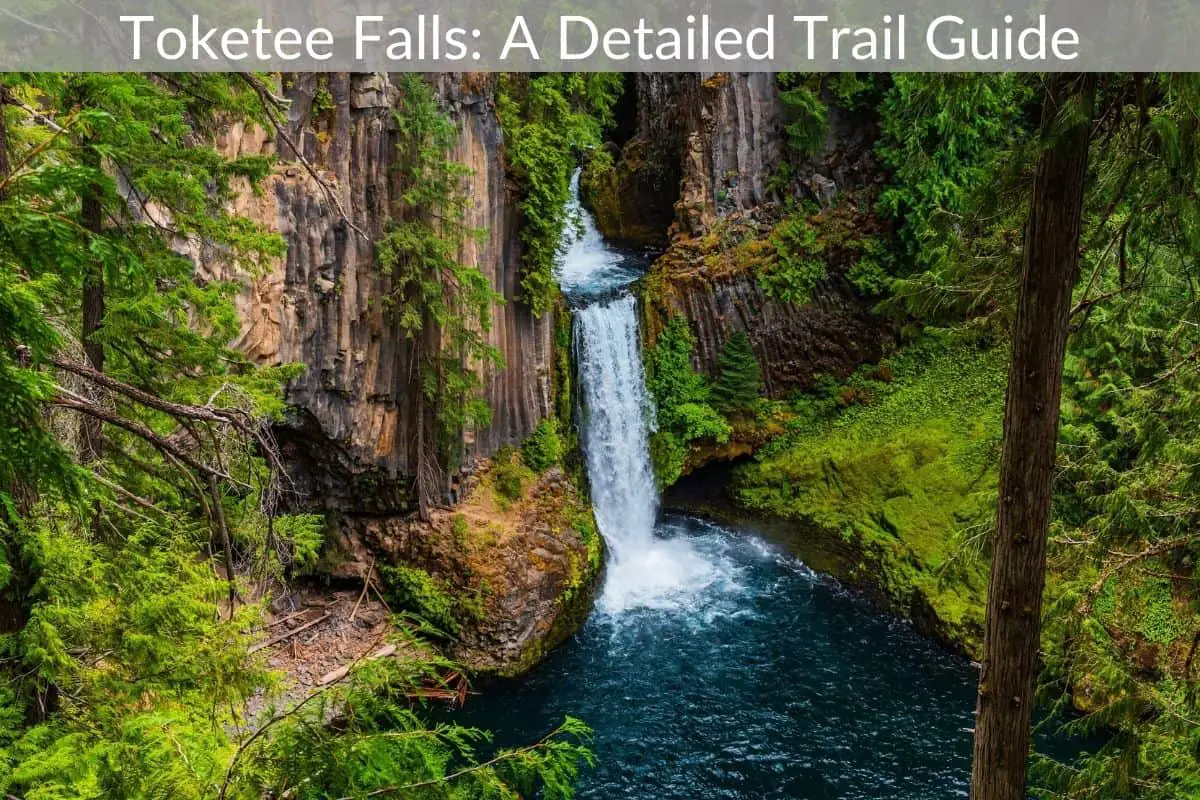Table of Contents
*This post may contain affiliate links. As an Amazon Associate we earn from qualifying purchases.
It’s your vacation and you’d like to take your family somewhere nice. These days, when most of us spend the majority of our time staring at electronic screens, maybe you’d like to take the family the great outdoors. Television and video games are wonderful. But this beautiful planet of ours has much to offer, lest we forget. If you’re trying to decide on an ultimate destination, consider Toketee Falls.
This blog covers everything you need to know about Toketee Falls and the surrounding trails.

Photo Credit from Edge Water Inn
Getting to Know Toketee Falls and the Surrounding Trails
As its name suggests, Toketee Falls, named after the Chinook word for “graceful,” is a waterfall located in the Umpqua National Forest in Douglas County, Oregon. Douglas County is on the southwest part of the state, about three and a half hours from Portland.
In two different tiers, the falls are about 120 feet tall. The upper fall is about 40 feet and the lower fall is about 80 feet.
Even though this isn’t among the tallest waterfalls in Oregon, it is certainly one of the most scenics. Surrounding Toketee Falls is luscious greenery and a gorgeous collection of trees. This includes Douglas-firs, Western red cedars, big leaf maples, and Pacific yews.
The falls are part of the North Umpqua River. It flows into a large, scenic pool. It’s the perfect area to find a soft spot on the ground, kick back and relax. You may also consider visiting the Umpqua Hot Springs.
The trail that takes you to Toketee Falls is aptly titled the Toketee Falls Trail, so there can be no confusion.
For older visitors or anyone who isn’t in tip-top physical shape, the trail is less than a half-mile long. It includes a bench about half-way through for hikers to rest their legs. A large part of hiking is knowing your limits. Even experienced hikers like to sit down to enjoy and soak in their surroundings.
The area is also a popular attraction for marriage proposals. So if you decide to make the trip, the waterfall might be the second most beautiful thing you see.

What is There To Do in Umpqua National Forest?
Once you’ve seen Toketee Falls, you’ll probably be primed for even more outdoor adventure. You might even take your cell phone and chuck it in the river, forever swearing to live among the trees. Okay, maybe your feelings won’t be that extreme. But you won’t be ready to go home just yet.
Thankfully, the forest is home to more than just Toketee Falls. In fact, AAA says there’s something for “nearly every outdoor enthusiast.”
Most Notable Attractions
1. Rogue-Umpqua National Scenic Byway
The Rogue-Umpqua National Scenic Byway has a long name for a reason. It’s an extensive, scenic road that winds through the forest for 172 miles, touching upon its most breathtaking sites.
This is a nice change of pace from the numerous trails. It’s perfect for older visitors who would like to explore the park but aren’t up to the physical challenge.
You’ll be driving by the Upper Rogue, Cascade Mountains, and the North Umpqua River. You’ll get to see the gorgeous Diamond Lake, which lives up to its name when it’s shimmering against the noon-day sun.
This road will also take you to the entrance of Crater Lake National Park, which is surrounded by fascinating rock formations.
All in all, this road will take about 8 hours to drive. It might take you a little longer if you’re pulling over to admire the sights, which is highly recommended.

2. The Vast Wildernesses
Umpqua wouldn’t be much of a forest without a healthy amount of wilderness. Sure enough, the forest has three large areas.
One of them is Boulder Creek Wilderness, which consists of 19,886 acres. That might sound like a lot, but it’s actually the smallest of the three areas. It contains the modest Boulder Creek, which is made up of some small pools. This is also a popular area for rock climbers, as there are monoliths aplenty.
One of the other wildernesses is the Mt. Thielsen Wilderness. This area encompasses a whopping 54,914 acres and nestles up to the Cascade Mountains. The titular mountain reaches an ultimate height of 9,182 feet, making it quite the journey up.
Unlike some of the other areas, this area consists of many open meadows. But it has its share of alpine forests, too. This area is also home to the Pacific Crest National Scenic Trail, which cuts through the wilderness for 26 miles. It provides the ideal perspective for admiring the natural wonders of the forest.
The last wilderness is the Rogue-Umpqua Divide Wilderness, which is 35,701 acres. This area has a particularly active wildlife population due to its abundant water sources and a varied plant offering.
There are two major trails that take you through this area: the Acker Divide Trail and the Cripple Camp Trail. While both offer fantastic views, it’s best to tackle them after July since the snow doesn’t melt until then.

3. Outdoor Recreation
If walking around isn’t exciting enough, Umpqua National Forest has of other outdoor activities to offer. One such activity is dog sledding, which probably isn’t something you get to do every day.
[amazon box=”B073V3JH1N,B015O7WNV2,B01BY6UDEQ” grid=”3″]
Naturally, dog sledding is only available in the months where snow is available. Location-wise, it’s available in four of the forest’s districts: the Cottage Grove Ranger District, the Diamond Lake Ranger District, the North Umpqua Ranger District, and the Tiller Ranger District.
If dog sledding isn’t your speed, maybe you’d like a peaceful night of camping under the stars.
The forest has 40 different campgrounds available, most of which include a table, a grate, and a living space.
Showers are only available at Broken Arrow and Diamond Lake campgrounds. Unfortunately, there are no electrical outlets. But, hey, it’s not an arcade. It’s camping.
Any fishing aficionado will tell you that fishing is all about location. This not only has to do with the body of water and the kinds of fish available but also the scenery, as fishing involving a lot of sitting and looking around.
[amazon box=”B07FVL7NK2,B00C6OUE2W,B07591GBWZ” grid=”3″]
Fishing is allowed in four different districts of the forest, which includes the Cottage Grove Ranger District, the Diamond Lake Ranger District, the North Umpqua Ranger District, and the Tiller Ranger District.

Keep These Things in Mind
When you’re having fun exploring the area, you might forget there are actually some rules to this nature stuff. But don’t worry, because they primarily exist for your own safety, as well as the safety of the forest itself.
First of all, in the warmer months, a special substance can grow in the waters called Blue-Green Algae. If this alga gets into the body of a human being, it can cause them to get sick. If it gets in the body of a dog, it can actually kill them, so watch your pets.
Anytime you go hiking or sightseeing in the wilderness, you should always do extensive research on the weather, not just of the day you’re planning to visit, but also for the days before and after. It’s best to be prepared for any possible situation.
As our mutual friend Smokey the Bear has told us, fires remain a constant threat among forests.
Keep an eye out for fires and be wary not to start a fire yourself. This preparation includes knowing how to properly extinguish a campfire and knowing never to use fireworks in a forest. Even something small, like a cigarette, can result in catastrophic damage.
Toketee Falls is Only the Beginning
Toketee Falls might be what entices you to visit Umpqua National Forest. But it’s nearby attractions keep you from leaving.
After you see Toketee Falls, take a drive down the Rogue-Umpqua National Scenic Byway. Not only will you get to see more gorgeous sights, but you’ll get to rest your weary legs.
Once you regain your energy, explore the forest’s many wildernesses. Each has its own unique flavor. If you’re still not satisfied, go fishing at Diamond Lake and cook up some rainbow trout at a nearby campground.
Given the vastness of the forest and its immense beauty, it’s a wonder anyone ever leaves at all.


